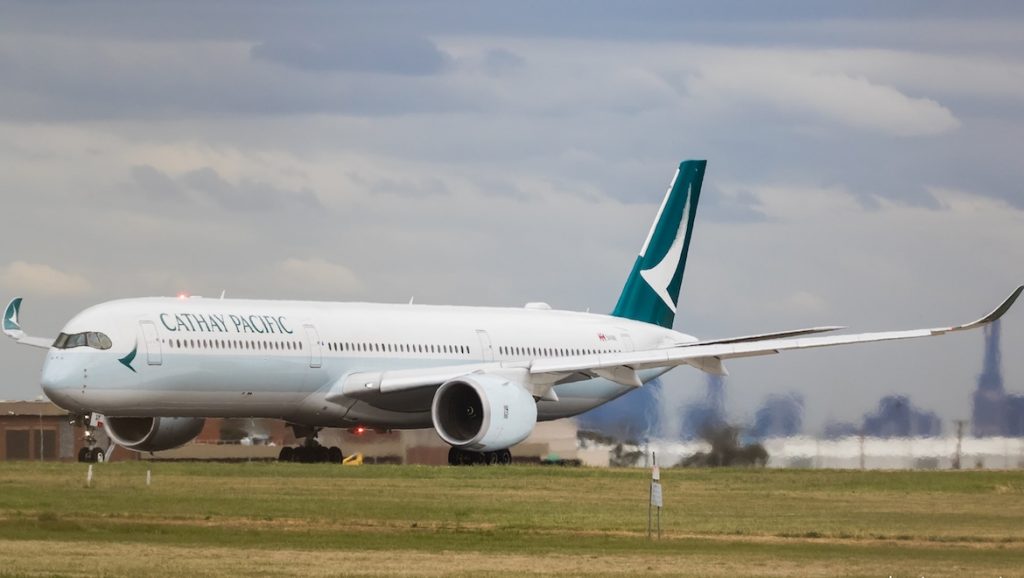
Cathay Pacific is reportedly working with Airbus in order to certify “reduced crew” single-pilot operations at high-altitude cruise for long-haul flights on the Airbus A350.
Under a program named Project Connect, the airline is working with the planemaker to certify the A350 for single-pilot operations in certain circumstances from as soon as 2025, in a move that could reduce crew costs for airlines.
By introducing the ability for a single pilot to operate the aircraft while cruising at high altitudes, Cathay would be able to man each long-haul flight with just one pair of pilots who would alternate throughout the flight.
The current system requires two pilots in the cockpit at nearly all times, meaning three to four pilots must be active onboard for long-haul services.
While a successful result for Project Connect would introduce long-term cost savings for airlines, the move is likely to be highly contentious in the international aviation sector, and will likely be fought against by pilot unions over safety and fatigue management concerns.
Sources informed Reuters about the ongoing development of Cathay’s single-pilot program, which is not dissimilar from a program that German flag-carrier Lufthansa recently worked on. However, the German airline has not yet introduced the system into its flights.
Cathay Pacific confirmed its involvement in the program, but has also not made a decision on if and when it will deploy the use of single-pilot operations.
“While we are engaging with Airbus in the development of the concept of reduced crew operations, we have not committed in any way to being the launch customer,” a Cathay spokesperson said.
The airline highlighted that any decision made would be of “absolutely no compromise on safety”, and that the use of single-pilot operations would be subject to extensive safety testing, regulatory approval, and additional pilot training.
“The appropriateness and effectiveness of any such rollout as well as [the] overall cost-benefit analysis [will] ultimately depend on how the pandemic plays out,” the spokesperson said.
Cathay said with all this in mind, it is continuing to engage with Airbus to “support development of the concept”.
Airbus has previously disclosed plans to add single-pilot capability to the A350, with work on the program temporarily paused due to the pandemic.
Airbus chief test pilot Christophe Cail confirmed that this work has now resumed.
“We’ve proven over decades we can enhance safety by putting the latest technology in aircraft,” Cail told Reuters, without naming any commercial airline interests, however did add: “As for any design evolution, we are working with airlines.”
The widespread deployment of single-pilot operations in long-haul flight would require a system in place to constantly monitor the solo pilot’s alertness and vital signs, according to the European Union Aviation Safety Agency (EASA).
Speaking of the concept in January, EASA chief Patrick Ky said systems such as these would be necessary to ensure the pilot manning the controls is not incapacitated, and can alert the resting co-pilot should this status change.
“Typically on long-haul flights when you’re at cruise altitude there’s very little happening in the cockpit,” Ky said.
“It makes sense to say OK, instead of having two in the cockpit, we can have one in the cockpit, the other one taking a rest, provided we’re implementing technical solutions which make sure that if the single one falls asleep or has any problem, there won’t be any unsafe conditions.”
However, pilot unions have already flagged concerns with the concept.
“We struggle to understand the rationale,” said Otjan de Bruijn, head of the European Cockpit Association, adding that the cost-cutting measure “could lead to higher risks”.
Pilots and unions have drawn upon historical fatal events, such as Germanwings Flight 9525, which have deemed it necessary to have at least two authorised personnel in the cockpit at all times
However, Project Connect still has a lot of certification hoops to jump through, including achieving the seal of approval from EASA and ICAO.










